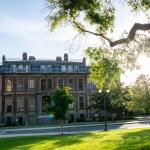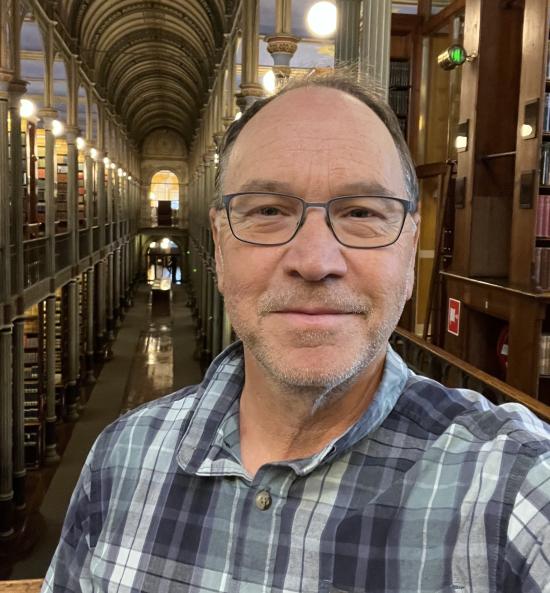Tim Tangherlini is a folklorist and ethnographer who is interested in the circulation of stories on and across social networks, and the ways in which stories are used by individuals in their ongoing negotiation of ideology with the groups to which they belong. He recently joined the School of Information in a joint appointment with the Department of Scandinavian. We spoke to Professor Tangherlini to learn more about the field of cultural analytics, his current research, and his favorite class to take and teach.
You have been a Professor in the Department of Scandinavian since 2020, serve as associate director of the Berkeley Institute for Data Science (BIDS), and recently, joined the School of Information in a joint appointment. How do these different disciplines work together?
In the Scandinavian department, I focus largely on folklore (along with literature and film). In folklore studies, I get to work with tens of thousands of variants of stories told by thousands of individuals.
When I was in graduate school, I was trying to figure out how to work with this many variant texts as well as understanding the historical conditions of all these largely rural storytellers. I came up with a model that I’ve been refining ever since, based on the idea of the macroscope, that people may know from de Rosnay’s writings or Katy Börner’s ideas for a plug-n-play macroscope. The macroscope, in short, allows one to focus on different scales of analysis, and learn at each of these scales to help answer questions across the entire corpus.
Clearly, this interest in working across scales of analysis led to the need to develop methods for working with text (and actually figuring out ways to digitize archival resources), methods for finding patterns in those texts, and devising ways to correlate those discoveries with aspects of storytellers and the environments in which they lived (and told their stories)! This was back in the late 80s and early 90s so, at least in the Humanities, I was a bit on my own. Luckily, I had always been interested in language (mostly dialectology and onomastics), mapmaking and computing, and so I found in folklore a perfect discipline to integrate these various approaches.
Over the years, these ideas have been refined into the burgeoning field of “computational folkloristics” and now include an approach that weds cultural analytics, including the analysis of text, sound and images, with approaches from complex systems, as we try to unravel the dynamics of informal, vernacular culture and how it circulates on and across social networks (a nice definition of folklore!).
What drew you to the I School?
When I was in grad school here at Cal, I took some really interesting courses at the I School; one that I remember vividly was focused on medieval manuscript collections, and attempting to use the features of manuscripts (codicology) as a dimension for classification. In many of my other classes, professors were largely baffled by my admittedly clumsy attempts at leveraging computing for answering cultural questions — but in the I School, there was a genuine interest in these approaches. In fact, that first year in grad school, I spent more time in the school’s computing lab than probably anywhere else, except maybe Doe. So, I am quite delighted to have been invited to join the I School, as that sense of curiosity and a willingness — perhaps even a compulsion — to cross disciplinary boundaries is very much alive among the faculty and students.
You have played a large role in the creation of the field of “culture analytics” and consider yourself a “computational folklorist.” What interests you about the field?
Cultural analytics — the data-driven analysis of cultural phenomena — rests on the recognition that the study of culture is too big and too complex for the monastic approaches that have characterized some of this study in the past. In the early 2000s, I was fortunate to be invited to join a program at NSF’s Institute for Pure and Applied Math that focused on the “Mathematics of Knowledge and Search.” What I found so appealing about that program was that the participants were attracted to hard problems irrespective of their origin, and that everyone could contribute with their own domain expertise to addressing these problems. No one seemed bothered by the fact that I was a Humanities scholar in a sea of applied mathematicians, computer scientists and other data scientists — they liked the difficulty of some of my questions as I liked the elegance of some of their approaches. I learned a great deal about machine learning and network methods (at a level that was admittedly a bit more advanced than my Humanities training had prepared me for), but also learned a great deal about collaboration. What I still find interesting is that many of the colleagues from that program with whom I continue to collaborate are at Schools of Information around the world.
As for computational folkloristics, it is kind of a natural thing: folklore is one of the first “big data” fields in the Humanities. We work with tens of thousands if not hundreds of thousands of records collected (or created) by equally large numbers of people in multiple languages and dialects, often recorded by hand or perhaps on wax cylinders. There is both change and stasis in the material, and so there is a dynamic aspect to the material. Folklorists largely agree that the material encapsulates aspects of cultural ideology but mapping that ideology is challenging. And folklore is necessarily anchored in social networks. The changing environment, both natural and manmade, influences the expression(s), while the technologies of transportation, communication and recording, coupled to the political motivations for collecting folklore all play into this complex situation. Of course, folklorists are inveterate classifiers and have been trying to classify things for several hundred years, all with an eye toward search and retrieval.
Some of my work is to try to let the material reveal the latent spaces of meaning-making encoded in the expressive forms themselves. Importantly, folklore isn’t solely concerned with story and text — [folklorists] are also interested in material culture, song, dance, clothing, foodways and on, so there’s also a need for an understanding of the interdependence of different forms of cultural expression and methods for tracing the ongoing negotiation of these forms and the ideologies that they encode. This approach can be extended more broadly to all forms of cultural expression and hence the ideas for cultural analytics.
Tell us about your current research.
My current research is very much grounded in cultural analytics and computational folkloristics. Right now, I’m working on a cool project about witchcraft and dairies in nineteenth century Denmark with a colleague in sociology. I’m also part of a group at the University of Copenhagen looking at how noise and sound are represented in 19th century Danish literature, which is related to my work on Hans Christian Andersen’s writing, particularly understanding the latent intertextual space between his fairy tales and his travel writing. My focus on 19th century rural Denmark is the basis of my contribution to a new Center of Excellence at the University of Copenhagen which just received 40 million Danish kroner to explore the cultural implications of transitions from rural to urban modes of social organization, so I am looking forward to being part of that and the opportunity to host researchers from that center here at Cal (and the opportunities for our students to work with the center as well!).
A great deal of my research is centered on understanding the circulation of stories-told-as-true on and across social networks, so social media has been a boon to my research. The work I have done on rumor and conspiracy theory has led to some great collaborations with network scientists at Rutgers, a fabulous collaboration with the SOCKS (Science of Online Corpora, Knowledge, and Stories) program at the University of Vermont with primary investigators Peter Dodds and Chris Danforth, and now a recently funded collaboration, under the leadership of YY Ahn, that brings together researchers from Indiana University, Boston University, and Stanford to explore narrative, belief and the ecology of misinformation; that project is just getting underway and I look forward to engaging I School students in this large scale, multi university research initiative. Finally, I am very excited about various new pose detection models that we hope to use as we devise a search engine for K-pop dance. While most of my work on Korean music has been decidedly not K-pop, the dance and the infinite fan videos and TikTok challenges are an incredible opportunity to explore variation and shifting conceptions of expertise, while also tracing influence and style.
I really love engaging students in my research projects, and so right now I have two student driven teams. One, nicknamed Facebook for Vikings, is a long term project on extracting character-interaction graphs from all 150 or so Icelandic sagas, and developing ways to interrogate and represent those networks. The other is based on a flavor network paper that came out in Science a decade or so ago. Our goal is to extract flavor networks from Nordic cookbooks going back to the end of the 18th century, and present an evolving representation of how flavors interact in Nordic cooking over the past two hundred years. Did Scandinavia taste the same in the 1780s as it does today?
What’s your favorite course you’ve ever taken or taught?
I’ve been lucky to take a lot of great courses from really inspiring lecturers. Perhaps the most fun I had in a course was one in grad school on the eddic poems — there weren’t a lot of us in the class, but we also tried to imagine different ways these poems could have been performed, and what they’d be like if they were performed today. Recall that some of these are kind of insult competitions, so the seminar could be a bit raucous. The course I have the most fun teaching is one on Nordic folklore, since we get to deep dive into all the archivalia and play with the various tools I’ve created for working with these stories. But honestly, I really love teaching and get caught up in the great ideas that are generated in class and in projects.
Share a fun fact about yourself.
While working on a Danish dairy farm in the 1980s, I encountered what everyone on the farm and others in the community assured me was the farm’s “nisse” or household spirit (long story and I’m still not sure how to interpret it — see this video),
Along with the bass player in a band I played with in grad school, I made two documentary films about Korean punk rock.
Anything else to share?
I am really eager to expand the cultural analytics footprint here at the I School. We are planning a speaker and workshop series, and we already have Friday afternoon get-togethers from 12 pm - 2 pm in room 6. We’ve got the Digital Humanities working group, and I’m focusing on cultural analytics, and open science, in my work with BIDS. So, I am more than a little excited to be part of the I School.










